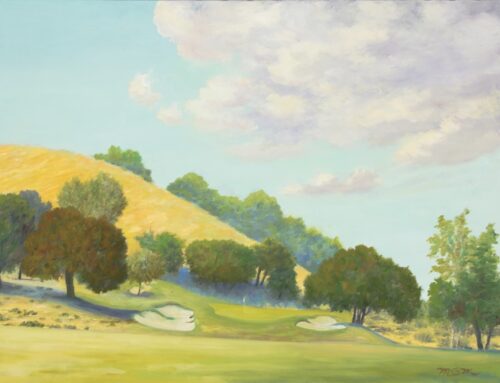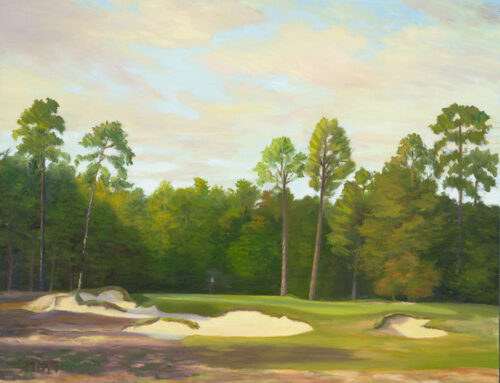Enhancing The Experience Of Golf Through Landscape Design And Environmental Psychology
by Jamie Black
‘Beauty means a great deal on a golf course; even the man who emphatically states he does not care a hang for beauty is subconsciously influenced by his surroundings’ (MacKenzie, Golf Architecture, p36)
The study of Environmental Psychology has built a substantial amount of information on how surrounding environments affect humans. Almost every Golf Course Architecture book ever written mentions the importance of aesthetics and how they can subconsciously influence the golfer. Both studies appear to have recurrent features that would help improve the experience of golf.
Environmental Psychology is a relatively new field of study that examines the interrelationship between environments and human behavior. It has a lot to offer in creating landscapes (i.e. golf courses) which are responsive to the requirements of humans who will be taking part in the setting (i.e. the golfers). Cognitive informational factors such as coherence, legibility, complexity and mystery all help to create ‘experience’ whether it be unpleasant or pleasurable. These elements can benefit Golf Course Architects when creating golf holes which impart feelings of grandeur, intimidation or possibly confidence within the golfer.
The golf boom of the late eighties in Great Britain, resultant of the R&A’s ‘Demand for Golf’ report (UK), lead to a surplus of characterless golf courses across Great Britain. A large number of these courses fell short economically and recreationally of fulfilling the public’s expectations. A distinctive feature of many new courses built was their excessive earthworks, non-vernacular designs and in some cases minimal provision for environmental issues. They were alien landscapes which did not ‘fit’ the land and led to a bland, forgettable experience. ‘Placelessness’ = Inability of a setting to encourage the formation of vivid images.'(Greenbie, 1981) This sums up the plight of many modern golf courses constructed in this time. They simply were not memorable enough.
Therefore it is proposed that to move toward the ‘experiental’ golf course the principles of Environment Psychology should be incorporated into the design process of Golf Course Architecture.
We process visual information in two stages in the mind. Pre cognitive (nearly instantaneous appraisal of setting) and Cognitive (need to discover more information).
The first stage (pre-cognitive) is the human action for survival. It is an instinctive reaction to cultural symbols relating to fear, comfort, danger, safety etc.
The second stage of Perceptual Process (cognitive) is more reasoned, it has a deeper sense of meaning. This more calculated cognitive stage of the Perceptual Process requires images of high enough complexity to sustain its interest, its need to discover more information and explore. Truly sophisticated golf design invites exploration, is complex and with each round presents a new challenge never to be got bored of.
To enhance the experience of golf first we must identify what makes a golf course enjoyable and why some golf courses are able to create a more memorable and enjoyable experience than others.
Coherence makes the golf course orderly. Distinct regions with repeating, unifying elements and textures (ie green, fairway, semi rough & rough) help increase the coherence. Complexity refers to the richness of the golf course elements that a designer places on an individual hole. ‘It is an important thing in golf to make holes look much more difficult than they really are. People get more pleasure in doing a hole which looks almost impossible, and yet is not so difficult as it appears.'(MacKenzie, Golf Architecture, p46). Legibility can be incorporated with some memorable components to help with orientation, ‘not necessarily thrills, because spectacular holes may be sadly overdone'(A.W. Tillinghast) In an easily legible setting one can remember each individual hole and the order they were played in. Mystery and the desire to explore or to whet the appetite for holes to come is greatly enhanced if there is some promise that one can find out more the further one goes.
‘It is important that a course should be a good one from the point of view of playing golf, but it is at least important, if not more so, that it shall be pleasing from the aesthetic point of view'(Tom Simpson)
Views throughout the course can greatly enhance the experience and enjoyment of golf. Close in views between holes are greatly enhanced by elevation change throughout the course, providing spectacular vistas within the golf property. Good composition can be achieved through leading the eye with various horizons to achieve balance and fine proportion. Ideally open space should disappear behind these lines to give the feeling of pleasant expectancy. This maintains interest for all golfers no matter their ability and regardless of their play. The feeling of mystery can be incorporated through a fairway disappearing round a tree line or slope. If the composition is not quite right all the original intent of the architects design can be lost. ‘All of the elements of a beautiful hole are there but the final work doesn’t communicate beauty’ (Hurdzan, Golf Course Architecture, p149)
‘A golf course’s reputation is among its principal assets. Reputation is what attracts visitors and societies, and is the very foundation stone of a club’s membership.'(Armitage, Improve your Golf Course at Low Cost, p3) This elusive thing called reputation depends a lot on the quality of the golf course. Strategy, aesthetics and conditioning when combined help create quality golf courses. For example when a player states pleasure or a dislike for a particular course the reason usually falls into one of the preceding categories.
In Britain there is a problem of the so-called ‘American’ course which does not relate to our surrounding countryside. They seem to epitomize bland, unfulfilled experiences for golfers. Conversely in the US the simple use of sod-stacked bunkers seems to qualify courses to be heralded as ‘Scottish’ even although most of the settings where they are found are totally inappropriate for a ‘Scottish’ style of design.
That’s not to say that architects have not noticed the trend. ‘Not all golf courses (in Britain) have to look like they were designed by Americans from a blueprint laid down somewhere in Florida'(Williams, GCNI, Vol 7 No 4, p 9) states European Institute Golf Course Architects’ Past President David Williams. The proliferation of ‘American parkland’ courses in Britain has sparked a renaissance in earlier design styles from a number of British architects. In short they are looking back to look forward. There was a spontaneity about courses built between 1900 and 1930 that is sorely missed today. Modern earth-shaping has become too fine and sanitized a production of art for it to give players the kind of pleasure that we receive from nature. A less calculated, rugged approach would significantly enhance many of the modern courses in Britain.
Too many new courses seem to be dis-jointed from their surrounds. Tee and Green complexes which ‘can be easily identified as an artificial structure should not be placed on a golf course.'(Kato, What Makes A Good Golf Course Good, p73). This also applies to the water hazard however ‘Many developers and public-course operators insist on a certain amount of water because the public equates water hazards with ‘better’ courses. But pandering to the public’s expectations makes our courses conventional rather than outstanding.'(Doak, The Anatomy of a Golf Course, p155) Herbert Warren Wind noted in an appraisal of MacKenzie’s design style ‘his goal of striving to create testing but natural-looking holes could not be more different from that of many modern golf-course architects who are adding to the plethora of strange new courses now finding a place on the P.G.A. tour’. (and that was written in 1929!) The participant has to be engaged with the landscape. This is absolutely paramount on a golf course, where, players are led from hole to hole. If they don’t feel involved then it is highly unlikely that enjoyment will be gained from their (incomplete) experience.
In conclusion, as available sites well endowed with natural landscape features are becoming less and less, more responsibility than ever before is on the Golf Course Architect to develop golf courses which chameleon nature, excite, intrigue, and are strategically sound to give the golfer a memorable experience, one which they would like to repeat again. Through a better understanding of how the mind interprets landscapes the designer can integrate these aspects into their designs. The differences between the expert golf course architect and the average golfer are particularly important to appreciate in order to design golf courses. The public do not think like the expert and it is vital this division is recognized if the public’s, not the architects, expectation of a golf course is to be fulfilled.
The End






